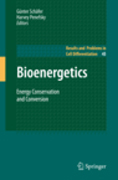
The present book addresses fundamental questions of biological energy transformation and conservation, with a focus on those processes which can now be understood on a structural basis. Current knowledge of selected examples of the biological energy conservation machinery such as cellular oxygen respiration, light-driven energy converters, and fermentation is reviewed. The machinery is highly variable, particularly that within microorganisms, but all of these devices universally rely on one unique underlying physico-chemical principle. Thebook is a rich source for specialists interested in recent developments in bioenergetics research and novices in the field alike. Anwers fundamental questions in bioenergetic research Rich on examples Suitable for specialists as wellas novices in the field INDICE: Diversity of the Heme–Copper Superfamily in Archaea: Insights fromGenomics and Structural Modeling. Structure of Photosystems I and II. Microbial Rhodopsins: Scaffolds for Ion Pumps, Channels, and Sensors. Life Close to the Thermodynamic Limit: How Methanogenic Archaea Conserve Energy. ATP Synthesis by Decarboxylation Phosphorylation. The Three Families of Respiratory NADH Dehydrogenases. Hydrogenases and H+-Reduction in Primary Energy Conservation. AStructural Perspective on Mechanismand Function of the Cytochrome bc1 Complex. Regulatory Mechanisms of Proton-Translocating FOF1-ATP Synthase.
- ISBN: 978-3-540-78621-4
- Editorial: Springer
- Encuadernacion: Cartoné
- Páginas: 325
- Fecha Publicación: 01/04/2008
- Nº Volúmenes: 1
- Idioma: Inglés
